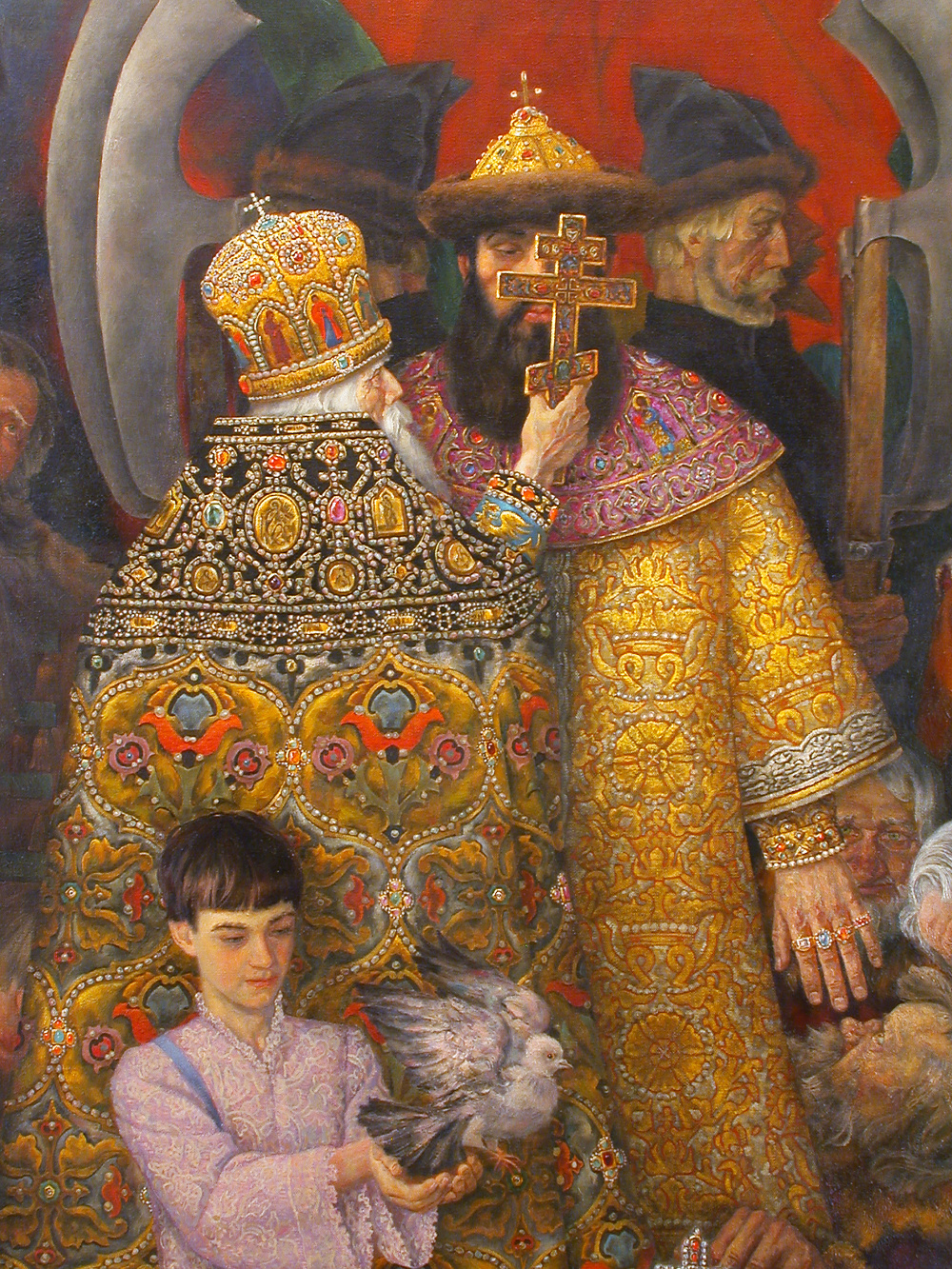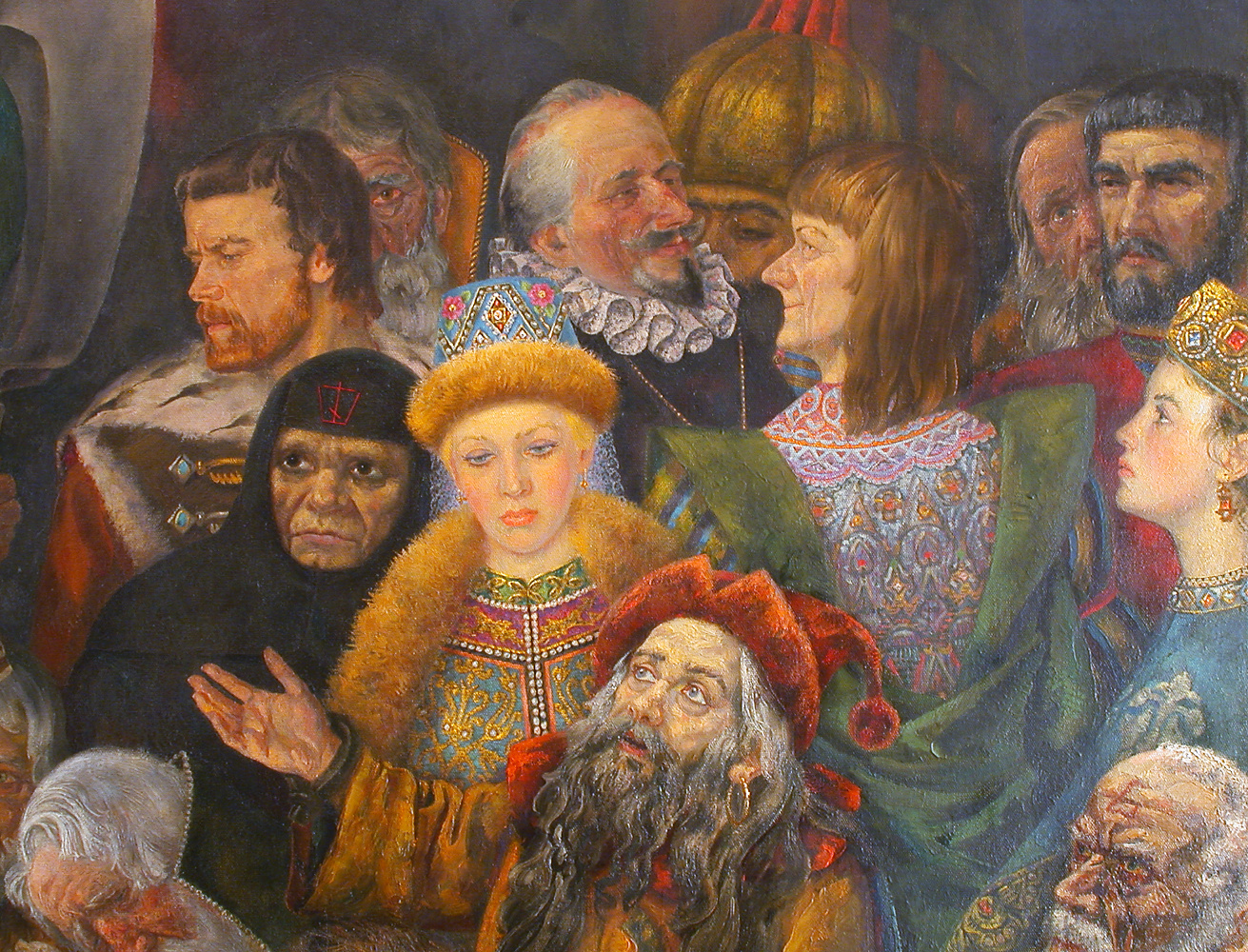The picture is written by oil paints (in main, domestic production) on the best only linen canvas under the name “repinsky” (four-thread knitting) from an integral piece by a size 320 cm. in height and 275 cm. in width. A ground glue, classical, four-layer, consistent, on sturgeon glue covered factory zinc white.
The picture formed within 11 years in period with 1977 for a 1988.
Is completed to 1000-years Christening Russ.
Engineering of painting multilayer, with sufficient drying between layers, are used numerous loss, are combined transparent and paste layers in painting. On a canvas the picture charcoal was not drawn for the greater safety of a canvas, and the figure was transferred (translated) with the help of realistic painting was observed. In one year after writing the picture was covered dim varnish is delicious.
The material to a picture was going within many years. For example, to represent the people in costumes of appropriate epoch, weight of ancient albums and books on a history of a costume was investigated.
I have stayed on epoch of the end 17 centuries. According to it 17 centuries were considered and draw in the sketches not only model and styles of costumes, but also ornaments of fabrics and jeweler ornaments and also attributes of a life. Especial attention I have paid on an imperial wear and attire patriarch, where ornaments is displayed original, including a famous cap Monomachs.
The basis of a plot of a picture is made by (with) a moment so-called “make on an empire”, that is moment, when patriarch of Russian orthodox church kiss of a cross bless of king on a reign. Usually this ceremony occurs in Assumption a cathedral of Moscow Kremlin before iconostasis at an altar, that has found imaging in some pictures of the Russian artists, for example, Serov.
I iconostasis have removed from a background to concentrate all attention on the people. Therefore I have kept only main three images in iconostasis, that is Christ, Virgen and Ioann, by writing them is conditional, by taking images from “deisusnogo” of a grade of the artist Feofan Greek in Blagoveshchensk a cathedral of Moscow Kremlin. By this background I have tried to express maximum spiritual ritual bless on an empire. Three figures on a background connect flyings the angels bearing good messages. Itself the authority, being in centre, close from the people by the armed protection also symbolizes not a unification with the people, and it the isolation, that always was in a history during centuries.
As main ruling Russian dynasty made family princes Romanovs, I, by studying faces of all kings since 17 centuries, have introduced as though general (common) type of a face, by representing is not concrete any Romanovs, and as though quintessence of their soft. Two figures in a picture have symbolical significance: it is the old man below at the left, sitting with the linked hands, expressing character old leaving Russ, and standing with the pigeon the boy personifying new Russia. The face reminds it boy Peter First, which yet clotnes, costs (stands) in a night shirt, and the time it has not come yet. The figure at centre in the fore-ground in the bottom of a picture keeping a scepter and orb, personifies eligibility of an authority of one king to other. Fool, sitting on bear-cub, specifying a hand on king, can speak and to think, how it is necessary, it anybody by tradition will not touch, that does not prevent falconer in green caftan at the left in the bottom of a picture smother of the person in the embraces.
The plot of a picture is those, but the large part of a canvas is taken by (with) the people, “standing a throne”. Them in a picture 33 persons, and each head I selected very carefully, trying to write not only face, but also to express a type, characteristic for different social layers of company. Here there are also simple people, the peasants, are two nuns, boyars, princes and foreigners. I composed them under the law of contrast, main law of art, that is a number, for example, with old nuns having taken vows of schema possessed a young face frade-people young boyaryshnia, near to Russian by a type represented east type and so on. And, some faces I wrote from a nature, as the national Russian type was changed for a little past centuries, and some faces transformed from features of the different people, trying to express character of the given person, for example, face nuns, jester, foreigner, insurgent and other.
Certainly, that I have represented in uniform space it seemed nonexistent things and phenomena, that is both bear, and pigeon, both angels, and sacred and real people has collected in one place, speaks that this picture both is real and is symbolical simultaneously. In a basis of understanding of a picture I have taken concept “realistic character”, as one of methods of realism in painting, that is many examples in a history of art, as, for example, picture El Greco “Funeral of the graph Opraca” or “Freedom on barricades” Delakrya.
In fortunately, any description of a picture does not give complete submission about a work of art – picture it is necessary to look!



